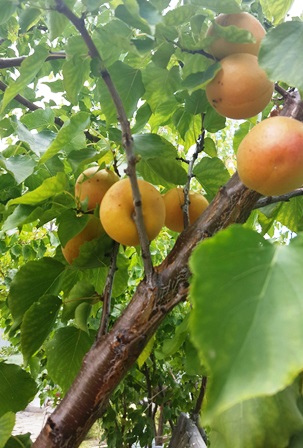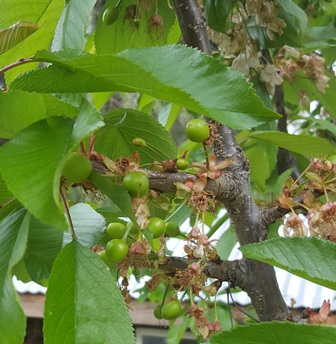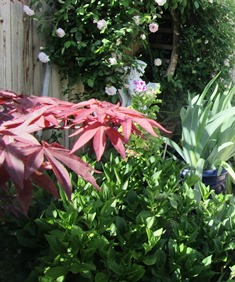How to Grow a Fruit Tree from a Pit
Nothing beats a breakfast of summer fruit picked fresh from a patio or backyard tree. I’m referring to fruit trees such as apricots, peaches, and nectarines. Cherries and plums are also among my favorites. The fruit from these trees is often referred to as stone fruit because of the hard pits (holding the seed) around which the fruit forms.

By mid-May, ripe apricots hanging on the trees in my backyard don’t last long–they’re eaten fresh, made into jams, and dried
Apricots in the Bay Area ripen in mid-May and peaches often ripen a bit later during the three months of summer (depending on the cultivar). If you love eating the fruit, don’t toss the pits. Consider that an apricot or peach grafted onto rootstock might cost upwards of $20 during bare-root season but $35 to $50 if sold in a pot. Growing from seed costs nothing.
Planting the seed extracted from the pit of your favorite apricot or peach variety can generate a tree with a very good chance of carrying the parent trees’ traits and producing fruit within three to five years. In fact, I’ve found that pits of my apricot, cherry, wild plum, peach, and nectarines that are left on the ground or discarded by the squirrels who’ve eaten the fruit will often sprout on their own.
Use this ten-step method to grow a peach or apricot tree from seed.
1. Choose a pit from a locally grown ripe fruit that tastes juicy and delicious.
2. Dry the seed on a paper towel in your kitchen window for several days.
3. Carefully crack open the hard shell of the pit to reveal the seed inside (it will resemble an almond).
4. Put the seed (or several seeds) in a sealed container in your refrigerator and let it chill for up to three months. The cool temperature exposure helps the seed get ready to sprout.
5. Time your removal of the seed from the refrigerator to a month before the last frost date in your area.
6. Cover the seed in water overnight and in the morning plant it a clear glass jar of potting soil (no lid on the jar).
7. Return the jar to the refrigerator and keep the seed moist until it has sprouted (about one month).
8. When the outside weather conditions are right (no more frost and the soil begins to warm), plant the seedling in your garden in fertile, well-drained soil.
9. Dig a basin around the planting hole for watering.
10. Mulch to keep down weeds and ensure the roots stay cool. In three years, watch for blossoms in the spring with fruit to follow.

Cherry pits are much smaller than other stone fruit; pits of sour cherries (and also wild plums) may self-seed but sweet cherries less so. Cherries must have a period of cold to germinate
* * *
If you enjoy farmette topics like gardening heirloom vegetables, herbs, and fruits as well as keeping chickens and bees, check out my Henny Penny Farmette series of cozy mysteries from Kensington Publishing–A Beeline to Murder, The Murder of a Queen Bee, and A Hive of Homicides.
You’ll find in the Henny Penny Farmette series
-
Delicious recipes
-
Farm quips and quotes
-
Tips for gardening and keeping chickens and bees
-
An exciting whodunnit mystery
Also, check out MY POCKET MEDITATIONS, my newest forthcoming nonfiction title from Adams Media/Simon & Schuster, at http://tinyurl.com/l6lzorq
![My Pocket Meditations: Anytime Exercises for Peace, Clarity, and Focus by [Lester, Meera]](https://images-na.ssl-images-amazon.com/images/I/51GH%2BXEPc6L.jpg)
Telltale Signs of Spring
As I write this, the honeybees are scouting every plant on the property. Awakened by warm weather and sunlight, they search for nectar. Aside from a few California poppies and other wildflowers blooming in front of the house, they won’t find much to forage on just yet.
Of course, there are a few apricot, nectarine, and almond tree blossoms as well as a smattering of white strawberry blooms in the raised beds at the back of our property. But within a few weeks, the warm weather of March and April will render the farmette virtually covered in masses of sweet offerings for the honeybees.
Still, there are the early signs of spring. The Japanese maples are leafing out in a dazzling show of red color. The pregnant stems of our bearded iris are swelling now for their Easter bloom cycle. And the Greek oregano is popping up everywhere as it does this time of year.
Birds are building nests, but I haven’t seen the red-breasted robins just yet. When they show up, searching for worms and grubs, I will know spring has truly arrived. Until then, I look for the telltale signs that Mother Nature is about to robe herself in the splendid garments of spring–fruit tree blossoms, leaves, blooming wildflowers, and lovely kitchen herbs pushing up all over the place.
 Facebook
Facebook Goodreads
Goodreads LinkedIn
LinkedIn Meera Lester
Meera Lester Twitter
Twitter









